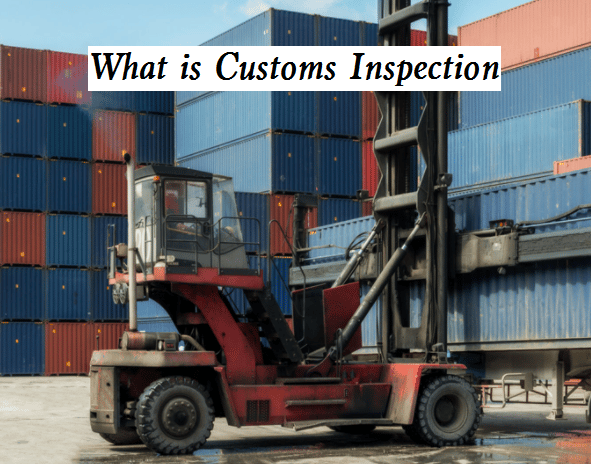Customs inspection is an essential step of freight transport. What is customs inspection, how does it work and how to do it? This article is going to take a look at the overview of the customs inspection with all details.

What is Customs Inspection?
Customs inspection refers to the administrative law enforcement act of the customs to actually inspect the goods after receiving the declaration of the customs declaration unit, in order to determine whether the nature, origin, condition, quantity, and value of the inbound and outbound goods are consistent with the detailed contents filled in the goods declaration form. Inspection is a kind of administrative power given by the state to the customs according to law, and it is also an essential and important link in the process of customs clearance.
Customs Inspection Purposes
The purpose of customs inspection is to verify whether the contents declared in the declaration process are consistent with the documents and goods inspected by checking the actual import and export goods and customs declaration documents, and find out whether there are smuggling violations or other import and export problems such as concealment, false declaration and the false declaration that cannot be found in the declaration and examination process. Second, the doubtful points raised in the process of declaration and examination can be verified through inspection, providing a reliable regulatory basis for taxation, statistics, and follow-up management.
Where to Do Customs Inspection?
Generally, the inspection should be conducted at the wharf, station, airport, post office, or other places under customs supervision at the import and export ports within the customs supervision area. For import and export bulk cargo, dangerous goods, fresh and living commodities, and goods transported by barge, upon the application of the import and export consignee and consignor, the customs may also check and release them at the operation site. Under special circumstances, upon the application of the import and export consignee or its agent and the approval of the customs, the customs may also send personnel to the factory, warehouse, or construction site outside the specified time and place to inspect the goods.
How to Do Customs Inspection?
The customs may conduct a thorough inspection or random inspection. Inspection operations can be divided into manual inspection and equipment inspection. The customs may determine the specific inspection methods according to the conditions of the goods and the actual law enforcement needs.
Manual inspection includes appearance inspection and unpacking inspection. Appearance inspection refers to the inspection of the packaging, transportation marks, and appearance of goods with intuitive external characteristics and easy-to-judge basic properties; Unpacking inspection refers to the inspection of the actual condition of the goods after the goods are taken out of the containers, container trucks, etc. and the outer packaging is removed.
Equipment inspection refers to the inspection of the actual conditions of goods mainly by using technical inspection equipment.
1) Full inspection includes unpacking (package) inspection of goods one by one, and a detailed check of goods variety, specification, quantity, weight, origin, and goods condition with goods declaration form one by one.
2) Selective examination: selective unpacking and spot check of goods according to a certain proportion, must be unloaded. The unloading degree and unpacking (package) ratio shall be subject to the requirements of inspection instructions that can determine the name, specification, quantity, and weight of the goods.
3) Appearance inspection: check the packaging, marks, and trademarks of the goods. The appearance inspection can only be applied to large machines, bulk raw materials, etc., which are not easy to handle and move. In addition, the customs also makes full use of scientific and technological means to cooperate with the inspection, such as a weighbridge, X-ray machine, and other inspection facilities and equipment.
The customs inspection department shall not exceed 48 hours from the acceptance of the inspection to the completion of the inspection and the feedback of the inspection results. The export goods shall be released within half a working day after the inspection. In the process of inspection, it is not subject to this time limit if it is found that there is a suspected violation of laws and regulations.
Customs Inspection Records
The customs should fill in an inspection record after inspecting the import and export goods. The records shall be filled in by the customs officer performing the inspection task. The contents of the inspection records generally include the inspection time and place, the name of the consignee or consignor of the import and export goods or its agent and the declared goods, the transportation package of the inspected goods, the name, specification, model, country of origin, natural attributes (quality, degree of newness, quantity (weight) Import and export status (raw materials, semi-finished products, complete machine, complete set of assembled parts, complete set of loose parts, etc.), sample extraction and inspection conclusion, etc. The inspection customs officer and the customs broker accompanying the inspection shall sign the full name on the inspection record.
The inspection record is the true reflection of the on-site inspection of import and export goods and is the official record and documentary evidence jointly recognized by the customs and the consignee and consignor of import and export goods or their agents. It can provide a reliable basis for customs taxation, statistics, and follow-up management, and is also strong evidence for the customs to investigate and deal with violations and handle tax disputes.
Customs Inspection Requirements
The Customs has the following requirements during inspection:
- The consignee or consignor its agent of the goods must be present, and shall be responsible for handling the goods’ moving, unpacking, and resealing, and the packaging of the goods according to the requirements of the customs.
- When the customs deems it necessary, it may directly conduct an inspection, reinspection, or take samples of the goods, and the goods management personnel shall be present as witnesses.
- The applicant shall provide round-trip transportation and accommodation, pay relevant fees, and pay fees according to customs regulations.